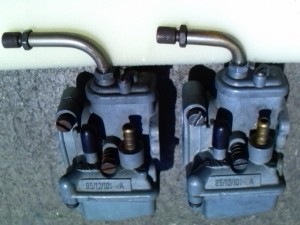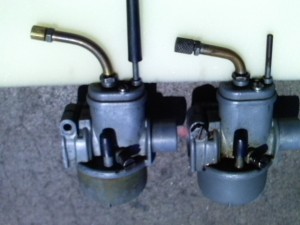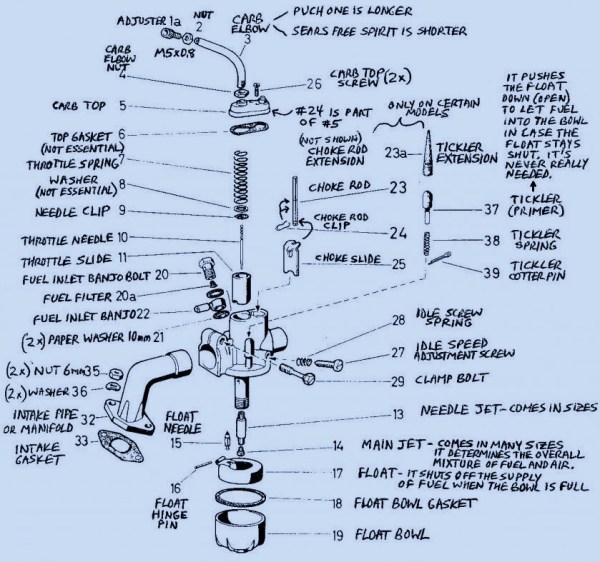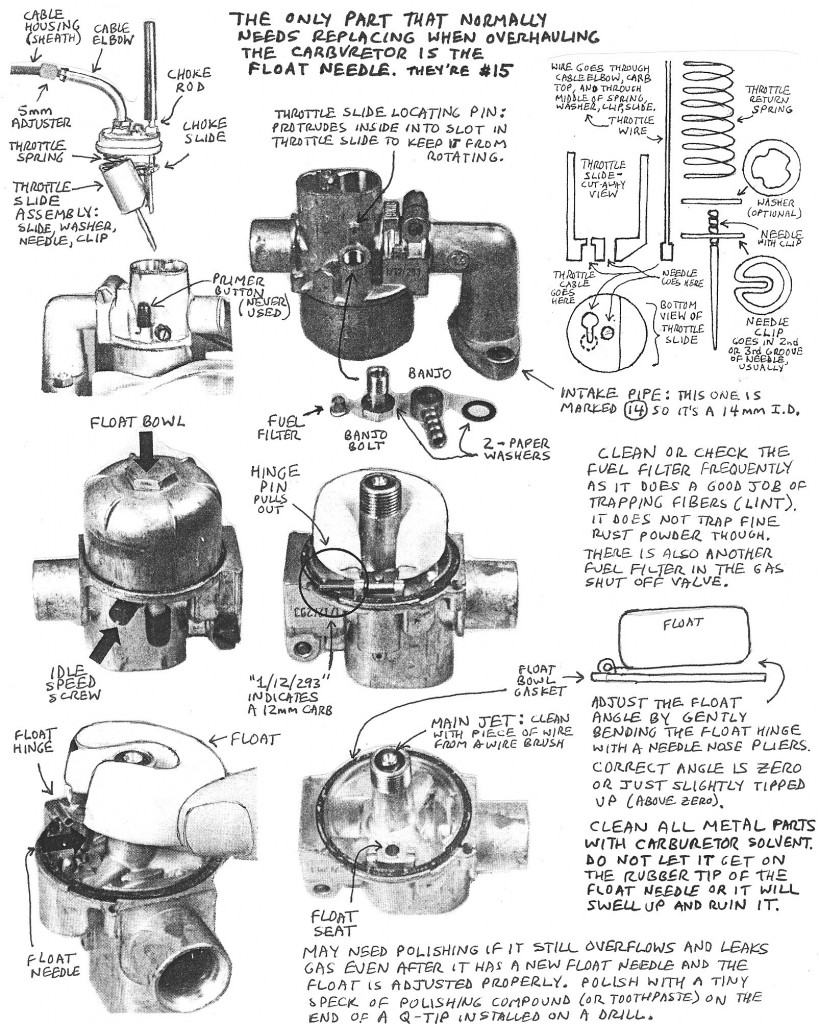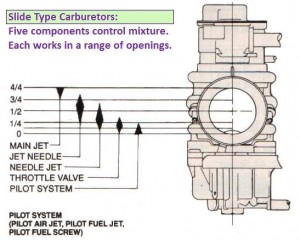 Contents:
Contents:
1. Carb Elbows: Long and Short
2. Exploded View and Parts Names
3. Carburetor Service Info Sheet
4. Float Needles: Rubber tip and Metal tip
4. Floats
6. Fuel Mixture is Controlled by Five Things
1. Carb Elbows Long and Short
Sachs Bing Cable Elbows: Left photo above, left is the long carb elbow, used on KTM Foxi, Sparta Buddy, and most Sparta Foxi models. Right, is the short carb elbow used on other Sachs engine models. The Sachs elbows are 7mm, not 6mm threads like Puch ones. The bigger elbow allows the throttle cable small end to pass through the 6mm adjuster. So Sachs double-ended throttle cables do not come with adjusters. The adjuster stays with the elbow. Puch Bings have 6mm elbow threads, and 5mm adjuster threads, too small for the cable end to pass through. So Puch double ended throttle cables have the 5mm adjuster trapped in them.
Puch Bing Cable Elbows: Right photo above, left is the long carb elbow, used on Maxi models, also with the black choke extension. Right, is the short carb elbow used on Magnum type models. The current aftermarket “Puch” throttle cables are made for the short carb elbow. They idle way fast if used with the long elbow, because the slide is not allowed to go fully down to idle. Myrons sells a long elbow throttle cable, for Puch Maxi, made from a modified “Puch” throttle cable. The wire needs to be about 12mm longer. The long elbow comes on Maxi type sheet metal frame models. The short elbow comes on Magnum type tube frames, such as Sears Free Spirit or JC Penney Pinto. The short elbow is so your foot does not hit it when you get on and off the bike. See the exploded view diagram below. Other Bing moped (under 15mm venturi) carburetors are the Sachs Bing, Kreidler Bing, Solo Bing, Tomos Encarwi, Batavus Encarwi, Trac Encarwi. Much bigger Bing carburetors are also on BMW, KTM, Penton, Sachs, Maico, DKW motorcycles, all made in or near Germany.
2. Exploded View and Parts Names
3. Carburetor Service Info Sheet
Below, the choke slide and throttle slide must be installed simultaneously. It is difficult. The throttle slide has a slot that must line up with a prong in the carb body. The top of the choke slide slides onto a deep wide notch at the bottom of the choke rod, so moving the choke rod moves the choke slide. It often gets left out or disconnected. When the choke slide is disconnected from the choke rod, the choke will be “on”, blocking off the air supply, whenever the throttle slide is down or closed. Normally when a Puch is given full throttle, the choke slide and rod are lifted all the way up until it clicks. The click is the choke rod clip #24 settling into the clip groove near the middle of the choke rod #23. When the throttle cable is not adjusted tight enough, the choke is not lifted all the way off, and it does not click until you manually reach down and pull up on the choke rod. When the throttle cable is adjusted too tight, the engine races and does not idle slow, even with the idle screw loosened all the way. See also General Carburetor Service and Jetting for how to clean and adjust carbs in general.
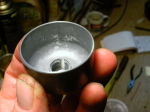
These white flakes were the cause of a customer’s Puch not running. By chance a tiny spec broke off and lodged in the main jet.
4. Bing Float Needles
All “Bing Puch Carbs” have the slotted float type float needle with a rubber cone tip, except for some of the Sears Free Spirit 1/14/163 and 1/14/164 carbs, which have a Sachs Bing type float needle that does not lock into a slot in the float and has a metal cone tip.
5. Floats
The original 1970’s floats were white. They weigh 5.6 grams when new. Modern replacements are black. They also weight 5.6 grams.
After years of exposure, the original white floats gradually absorb ingredients from the fuel and oil. They turn color, first light gold, then gold, then orange-gold, then light brown. The darker the color the more wight they gain, and the less they float. Orange-gold used floats weigh 5.8 g, light brown ones weigh 5.9, brown ones weigh 6.0 g.
6. What part controls mixture depends on how much throttle opening
